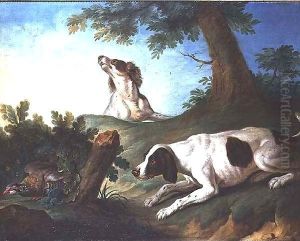Johann-Michael Baader Paintings
Johann Michael Baader, not to be confused with any contemporary figure, was an 18th-century German painter and plasterer. Born in 1707, Baader's life and work were situated within the context of the late Baroque and early Rococo periods, which were characterized by elaborate ornamentation and dynamic forms in art and architecture.
Baader's career was largely based in southern Germany, where he contributed to the rich tradition of stucco work and fresco painting that adorned the churches and palaces of the region. His work would have been defined by the intricate detailing and flowing lines typical of the Rococo style, which was becoming increasingly popular during his lifetime, especially in the ornamental aspects of interior design.
Despite the relative obscurity of Baader today, his contribution to the arts during his time would have been significant, as the demand for decorative arts was high among the nobility and the church. The stucco work and fresco painting of this period were not only artistic expressions but also symbols of power and wealth, and artisans like Baader played a crucial role in creating these manifestations of cultural and social identity.
Throughout his career, Baader would have been involved in the collaborative efforts typical of the time, where painters, sculptors, and architects worked closely together to create cohesive and harmonious interiors. His work, like many artists of the time, would have required not only artistic skill but also a deep understanding of materials and techniques specific to his trade.
Johann Michael Baader's death in 1792 marked the end of a life dedicated to the decorative arts. While individual achievements and specific works are not widely documented, his career as a painter and plasterer would have left an enduring imprint on the buildings that housed his work. The legacy of artists like Baader is often collectively preserved in the surviving examples of Baroque and Rococo architecture and design that continue to be studied and admired for their historical and aesthetic significance.
